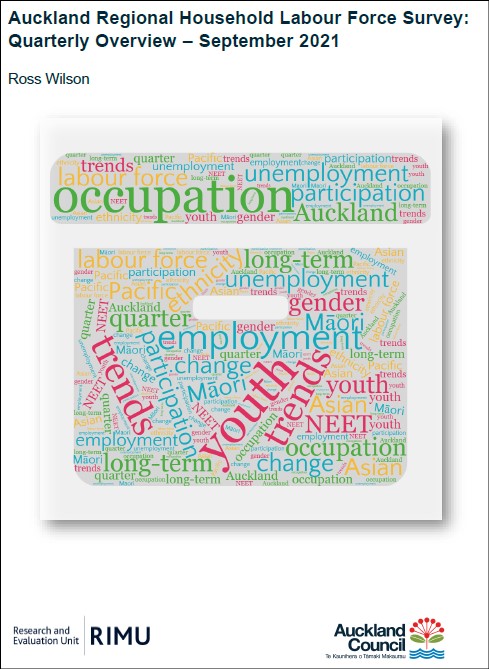Auckland regional household labour force survey: quarterly overview September 2021
Author:
Ross WilsonSource:
Auckland Council Research and Evaluation Unit, RIMU | Statistics New ZealandPublication date:
2021Topics:
EconomyAn overview of labour force participation in Auckland, as indicated by results of Stats NZ's quarterly Household Labour Force Survey. HLFS
Overview and highlights
For September 2021 quarter, compared to the preceding quarter (not seasonally adjusted):
• Auckland’s unemployment rate fell to 3.1%, the lowest since 2007.
• Persons unemployed (31,300) fell by 8700 since June 2021 (40,000).
• Persons employed (971,300) grew even more (+27,300).
• NILF (not ‘actively’ seeking work) (385,100) fell by 14,800 since June (399,900).
• The labour force participation rate (72.2%) was slightly above June (71.1%).
• Weekly hours worked was similar at 37.7 (average including full and part-timers).
• The NEET (not in employment, education or training) rate for youth aged 15-24 was 10.6%, similar to June (11.3%) and to the rest of New Zealand (11.3%).
Over the year ended September 2021:
• The unemployment rate averaged 4.4%, similar to a year prior (4.6%).
• The unemployment rate among those aged 15 to 19 averaged 18.2%, - slightly above 16.4% a year prior, but lower than 2009 to 2017 (2011 hit 31.0%).
• The unemployment rate for females of all ages averaged 4.6%, slightly lower than 5.0% a year prior. Males averaged 4.3%, same as a year prior (4.3%), so the gap between males and females is now minimal (0.3%).
• Unemployment rates varied by ethnic group: Pacific people (8.6%) were slightly above the year before (7.6%); Māori (7.7%) similar to the year before (8.1%); Asian (4.5%) slightly down (from 4.8%) and European (3.3%) slightly down (from 3.6%).
• The labour force participation rate averaged 71.1%, similar to a year prior (70.1%).
• The labour force participation rate for females (65.7%) and males (76.7%) was similar to a year prior (64.9% (still above 1995’s 57.3%) and 75.6% respectively.
• Labour force participation rates rose marginally from a year prior for ages 15-19 (40.8% from 38.9%) and 20 24 (78.1% from 76.2%); other ages were unchanged.
• Labour force participation rates were similar to a year prior for European (72.3%), Māori (67.1%) and Pacific (62.8%) ethnicities but rose slightly for Asian (74.6%).
Overview published November 2021.
